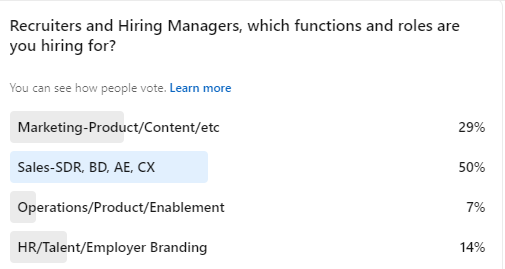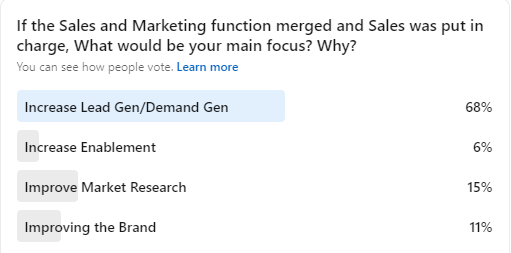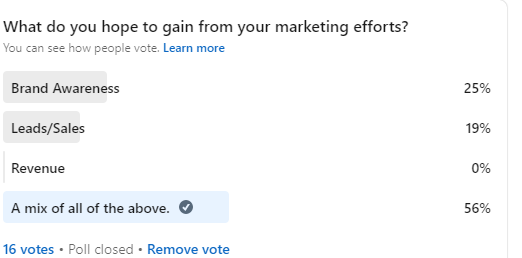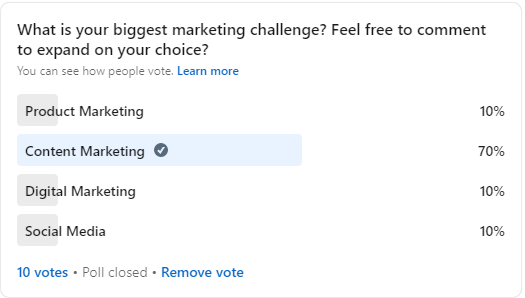Sales & Marketing Strategies for Enabling Sales Teams, Handling Objections, Closing More Deals & Increasing Sales
Sales processes include the following: customer development, prospecting, discovery calls, closing deals, cross-selling, upselling, post-sales implementation, customer experience, obtaining referrals, and testimonials.
What is the hardest part of the sales process?
I surveyed my LinkedIn audience to find out.
Survey Results
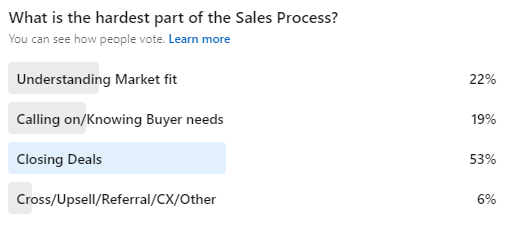
Of those surveyed, 53 % said closing deals was the hardest part of the Sales Process, followed by understanding market fit at 22%, Calling on buyers, and knowing their needs at 19% with the lowest being cross-selling, referrals, testimonials, or other reasons at 6%.
Based on these findings, I have included nine ways to enable sales teams to close more deals.
9 Strategies to Empower and Enable Sales Teams to Make more Sales
1. Have Sales and Marketing Management discuss Sales Cycle mapping out Sales, Marketing, and the Customer Journey.
2. Have Marketing go with Sales on calls to observe customer interactions regularly.
3. Take notes from Sales calls to develop answers to customer objections.
4. Role play with the Sales to get better at objection handling.
5. Develop an on-demand LMS for Sales including Decks, Videos, Sales Training materials, Product training materials, Scripts, and FAQs.
6. Use feedback from Sales calls and objections to improve Sales and Marketing Collateral.
7. Assign readings on sales strategy and techniques.
8. Conduct market research to show how is your products and services are better than the competitor. Present market research creating a chart that Sales can refer to when dealing with customers.
9. Develop buyer personas to understand customer buying motives. Share the buyer personas with Sales.
8 Techniques to Overcoming Customer Sales Objections
In sales, everyone has to be able to overcome objections to be successful. The best way to overcome objections is to prevent them. This can be done by providing a thorough sales presentation that covers all the information about your products and services. Also, you must address any questions the prospect has immediately. However, objections will come up from time to time. Some of these objections are real buying signals and others are just stalls to put you off. As a Salesperson, you need to be able to tell the difference.
Handling Objections & Stalls from Prospects
1. I am happy with my current supplier.
When you call on a prospect they say we are happy with our current supplier, this can mean one of two things. The first is that they are truly happy and the second is that they want you to get lost. (A stall) You need to be able to tell the difference. You should be able to tell by a prospect’s body language and level of attention.
If it is the first scenario, you should find out what supplier they currently use. When the prospect tells you it is your job to demonstrate how you are better. Once you feel that you have demonstrated how you are better, ask for a commitment or small order. By asking for small order, you provide the prospect an opportunity to take a chance on you with minimal risk. I have had a lot of success with this approach.
If the scenario is the second one, the prospect will not provide you with any information or say that they deal with a company or person for 20 years and they do not want to change. In this case, I would still ask for the order. Should the prospect say he is not interested again, I would thank them for their time and leave. You should call on this prospect a few more times and then only call on them every two months. You need to focus your time on prospects that are receptive to you and your offering.
2. I want to think it over.
When you hear this, what the prospect is saying is I am interested but I am not convinced. You should ask the prospect what specifically about this offer do you want to think over? Your goal here is to uncover the real objection. If the prospect gives you a specific answer, you are in business. Address the objection and ask a closing question. Say if I can handle XYZ, is there any reason why you would not purchase this product. Should the prospect say, no you covered everything, this means that they are either stalling, not interested in your offering, or will not tell you the real issue they have with your product. If this is the case, ask when they plan on making a decision and follow up with them in that time frame.
3. I need to consult another party
This can be a stall to put you off. You will need to determine this by the prospect’s body language and the level of attention you receive. When the prospect tells you this, you should ask for a meeting with the prospect and the person they need to consult. Should the prospect agree to this, you have a chance. If they will not agree to a meeting, it is a stall and they are not interested in your offering. However, I would still call on them a few more times. If you have no success, call on them every two months.
4. I am not the Decision-Maker- The Columbo Technique
During some cold calls to dental offices, I was not able to obtain the information that I needed to overcome prospect objections. This occurred because the person I was speaking to was not the decision-maker. As a result, they were reluctant to talk for fear that they would say the wrong things or give away too much information on their bosses’ business. Despite their reluctance, I would continue to talk with them, build rapport and bond. I would ask to speak to the decision-maker but many times they were not in the office, or the person I was speaking with would not want to disturb them for fear of getting reamed out when I left the office.
When this was the case, I would use the Columbo technique to get the information that I needed. I would turn to leave the office, put my hand on the doorknob and ask who their supplier was or when I could catch the boss. Usually, the person I was speaking with would provide me with a lot of information about the prospect. Even more, than I expected! This is because the person that I was speaking with put their guard down. After all, they thought I was leaving the office so one last question didn’t seem so bad.
During other cold calls, I was able to speak to the decision-maker. I would build rapport with them and try to obtain as much information as I could to overcome their objections. Many times the prospect would be reluctant to give me information; stating that they were happy with their supplier or they were too busy to speak to me. When they used the supplier objection, I would employ the Columbo technique; turn to leave and ask who their supplier was. Many times they would tell me and I would ask them for a few moments of their time to show how my products were better. I would get the time and close the prospect on giving me a trial order. I developed some of my best customers this way. Other times, I was able to obtain a follow-up appointment with the prospect.
The key to the Columbo technique is to get prospects talking. Even if it’s about things not related to their business at first. You want to make them comfortable talking with you. Next, you want to save the question you want to know for the end of the conversation because the prospect will most likely answer it thinking you are going to leave their office. In other words, their guard is down.
The Columbo technique is a great way to close sales and obtain information.
5. Your price is too high.
Emphasize the quality of your product along with the level of service you will provide. Next, you should demonstrate to the prospect how your offering’s total cost is less than the competitors over the life of the product. This is when you can bring up the competition showing how your products are superior in terms of product features and benefits using market research. Testimonials or social proof from loyal customers can also help. By taking these steps you demonstrate that your product is valuable and increase your chances of making the sale. (Provided this is the real objection.)
6. We spent our budget.
If they say the money is not the budget, ask If I can offer delayed billing or a payment plan would you be able to take delivery? If the person needs approval from another person, ask to present your product to that individual with your prospect’s endorsement. Should the company want and need your product, they will find a way to pay for it.
7. I had a bad experience with your company.
I would apologize to the prospect about the experience. Tell them you are the new rep and that you will not let anything bad happen on your watch. Ask them to give you a chance. This will not work all of the time.
8. Call me After the Holidays.
During the holiday season, many people are in holiday and party shopping mode. from Black Friday, Cyber Monday, and many other things. Also, everyone is thinking about going to parties. So the last thing on your customer’s and prospects’ minds is to make a year-end purchase; unless they receive a year-end tax advantage. As a sales rep, you are under pressure to close deals so you can earn that bonus. Unless your customer is in a buying mood, you are going to hear the objection “call me after the holidays”. If you have done business with this customer, you will have an easier time than if you are making a cold call.
To combat this objection. You have to attempt to get around this objection. If your offer is time-sensitive or if you can provide a break on pricing or payment through a special promotion for example no payments for 3 months; make your customer aware of them. However, at this time of the year, you will get customers and prospects who just don’t want to deal with you and your offering. As a sales rep, it is your job to be able to tell if the customer and prospect are telling you the truth. In other words, you need to qualify their objections. This means following up with every customer and prospect even when things look bleak.
Should your customers and prospects insist that call you after the holidays, I would find out which holiday they mean. Next, I would pin them down to a specific day and time to call back. I recommend sending your customers and prospects a holiday card with a little note reminding them about the appointment; stating how you look forward to speaking with them on the specific date and time. Once this time comes, I would hold them to their promise. Deliver your presentation and ask for the business.
Why Customer Objections are Sales Tools
When the Customer does not ask questions about a product or service it demonstrates a lack of interest. Sales objections are sales tools because the customer shows interest by asking questions. These questions allow the Salesperson to build rapport and trust with potential customers. They get to demonstrate their product knowledge and expertise. Without any customer objections or questions, reps have no way to measure their progress during the sales call; making it impossible to pivot. This makes it hard to make sales and build a relationship with the customer.
Why Customer Objections are Marketing Tools
Certain things come up when customers raise objections. Over time, Salespeople will be able to see patterns of this objection. Objections are raised about pricing, bad past experiences, budgeting, being happy with a competitor, and product inferiority. While Reps need to be able to handle objections; if they keep losing the sales for the same reason, they need to share this information with the marketing and product development teams.
How Marketing Can Help Sales
Based on the feedback from Sales, Marketing Teams can Create and improve Sales/Marketing Collateral to address potential objections. Customer objections are Sales and Marketing tools because they provide customer intelligence that can be used to sell more/improve products.
Sales Teams
Sales teams can provide a lot of information about customers, product concerns or issues, and objections they face. They are front-line soldiers that have a direct line to customer intelligence.
Integrating the Sales Team into your Marketing Strategy
Meet with the sales team and encourage them to compile a list of customer complaints, objections, and questions about products that they face. Ask the team to create materials that address these concerns that customers can access. This could take the form of blog posts, PowerPoints FAQs, product demonstrations, and tutorials.
If the sales team feels uncomfortable creating content, they could be interviewed by the marketing department. The marketing department could take content /basic materials, emails from the sales team and polish them up into visually appealing content that customers can access.
Customer Service & Service
Similar to the sales team, your customer service and service teams are front-line soldiers to help customers with issues they face at call centers or through social media. Ask them to write down complaints they get from customers with the answers. These complaints of FAQs could be put up on a website via a PowerPoint presentation, blog, etc… If this is not possible for the team, interview them, collect basic materials, emails, notes and create the content yourself.
The sales and customer success and service team are an important part of a marketing strategy for customer retention. The more products a customer uses from a brand, the less likely they will switch to a competitor. Remember it costs more to obtain new customers than it does to keep existing ones.
Cross-Selling & Up-Selling
Sales, Service and Customer Success teams can also help with cross and up-selling by sharing promotions and new offerings with customers. The Sales and customer service functions of brands are essential to creating a great experience for customers.
This is how brands can integrate Sales and Customer Success and Service teams into their marketing strategy. How are you using content from sales and customer service teams to help your brand retain customers? What are the goals of your brand’s marketing efforts?
Obtaining Testimonials
Once you have made a sale to a customer, it is important to follow up with them. In Sales, it is important to deliver on the promises you make to customers. This means checking in with the customer throughout the implementation of your product or service. Staying in touch with a customer post-sale is also important to earn repeat business and referrals.
As an outside sales representative in New York City, making sales was the highlight of my day. Once I made a sale, I was itching to ask for a referral or a testimonial. In other words, I wanted to ask the customer the question Do you know of anyone who could benefit from my product and services? However, once I made the sale, my inner voice told me not to ask for a referral.
Now many people would want to ask because they feel that the customer bought their products or services and this shows a sign of trust. But what did the customer buy? Yes, the customer bought you and your products but the main thing that they bought was your promise to deliver value through your offering. How can you ask someone to put their credibility on the line when you and your solution are unproven? Yet many people do.
Asking for a referral right after the sale is a mistake because you have not delivered on your promise and you will seem ungrateful. The customer will think that you are not interested in building a relationship and that you just want to make a commission. Remember your job as a Salesperson is to build relationships with customers and to make sales by demonstrating the value of your products to the customer. Once the sale is complete, it is your job to deliver on the promises that you make to your customer.
When to Ask
Now you are thinking well this is great but when do I ask for a referral? How do I ask for a referral?
I would ask the customer for a referral when I know the customer is happy with the implementation of your product or service. In other words, ask when you have delivered on your promise. If you offer more than one product or service try to cross-sell or upsell the customer first. See if the customer will use more of your products or services or if the customer purchases more expensive offerings from you. Once the customer purchases more items from you, the customer is demonstrating that they like and trust you. This is the time to ask for a referral. I usually waited until this point to ask for a referral.
Ask the customer for a referral by thanking them for the business that they have provided. I would then ask if they knew of anyone like themselves that would benefit from my offering. My experience has taught me that customers were always willing to offer themselves as a reference. Customers who offered me a referral would let me use their names with other clients or pass my name along to their peers.
Testimonial Formats
Testimonials are like referrals. Testimonials can come in a variety of forms. There is a testimonial letter and a testimonial video. The testimonial letter is when a customer writes a letter stating that you did a wonderful job for them and endorses you. The digital version of this letter is the recommendation feature on LinkedIn and,/or uploading a letter to your website. The testimonial video is when a client speaks of your performance in a short video segment. This can be done by the sales or marketing team depending on if there are customer advocacy or referral marketers on your team.
When asking for a testimonial, offer the customer the option to choose the option they feel comfortable with. Also, be sure to tell them what specific aspect of your service you want them to focus on. Once you receive a referral and/or testimonial, make sure to thank your customer. Should you get new business through a referral, provide great service otherwise your customer will not give you anymore! Keep your customer informed on the status of the relationship with the referral.
Customer Evangelism
Providing customers with great products and experiences is a great way to get customers to help market your products and services.
Below is an example of how Hyundai used customer marketing & testimonials to roll out Connected Care at the NY Auto Show.
Previously, I wrote an article about what the auto show could teach us about trade show marketing.
Hyundai made one of the best presentations of this particular show. They dared to be different. Instead of the traditional press conference, where journalists sit, take in the information and ask questions post-conference, Hyundai included a Q & A session right into the presentation. The conference was not a conference at all; it was a town hall. John Krafcik, CEO of Hyundai Motor America, used the opportunity to roll out Connected Care. This is a service that allows drivers to get help in case of emergencies. The service also updates owners on the health of their vehicles.
To back up their claims, they had customers provide in-person testimonials of how their lives were saved. One of their customers survived a head-on collision thanks to the service. Unable to contact his family, the service notified them of the customer’s condition. Now that’s a testimonial. If I need a new vehicle, I would strongly consider buying a Hyundai.
The live customer testimonials are worth their weight in gold. Prospects will believe what customers say over any marketing campaigns that brands create. This is a strategy that any business or brand can use. Offer quality products and a great customer experience. Serve customers in this way, and they will be more than happy to share their stories with the world! This is the best kind of advertising that anyone could ask for. Certain customers may even become evangelists.
Customer Appreciation
The easiest way to make sales is to earn referrals and testimonials from your customers. Customers are usually delighted to provide referrals and testimonials for products that work. However, you need to show your appreciation to your customers who put their name and reputation on the line for you.
How you show this appreciation could take many forms. You could bring them baked goods or take them out to dinner. Taking them to a sporting event or concert of their choice is a great way to build your relationship. Find out what type of gift your customers want and try to get for them if it is feasible. Remember to do a good job for your new customer!
Customer Loyalty & Reward Programs
Another thing you could do is to show appreciation is to provide customers a coupon for 15 percent off any item that you sell once their referral has been converted to a sale. I would also provide a thank you note with the coupon. Also, I would develop a point and reward system that encourages your customers to provide you with more referrals. Credit card companies use a rewards and points system when customers make purchases. This can be a model you can copy and implement; depending on your budget. Gift cards can also be an option.
Building Communities
Brands can create online and offline events for loyal customers to reward them. They can also create user groups on social networks such as LinkedIn, Facebook, and Slack.
Brand Ambassadors, Referral, Affiliate & Influencer Marketing
Brands can also develop a brand ambassador, referral, and/or affiliate marketing program. Some brands use influencer marketing to help sell and market products. Some influencers are celebrities but some brands use micro-influencers that are known in a particular industry.
Remember, word-of-mouth marketing is a great tool to earn new business. Taking the time to say thank you is well worth the time and effort. Your customers have more weight with your prospects than you do! Let your customers help you earn new business. Your existing customers are one of the best sources of new business. Turn these customers into Apostles.
What Sales and Marketing strategies have you used to: enable sales teams, to make more sales, close more deals, and, open new relationships?
Share your thoughts in the comments.
Additional places to find my content and blog
WordPress: http://dangalante.me/
Tumblr: http://www.askdangalante.com/
LinkedIn: https://www.linkedin.com/today/author/DanGalante
Medium https://medium.com/@DanGalante
YouTube https://www.youtube.com/trendsettingsm
Anchor https://anchor.fm/dangalante
About Me
I’m a Strategic Marketer with Field Sales, Sales Enablement, Content Creation and, Classroom Teacher/Trainer skill-sets using Marketing to drive Sales/Growth.
As a Marketer, I’ve worked with Start-Ups, a Political Campaign, and a Digital Marketing Conference. I’m certified in Inbound Marketing with classes in Marketing, Product Management, Product Marketing, SEO, SEM.
Before teaching, I was an Outside Sales and Marketing Rep. selling and marketing dental products to Dentists using consultative selling, trade show marketing, field marketing, and market research.
I publish Sales, Marketing & Social Media Today a blog covering industry events and trends.
Articles and insights have been featured, mentioned, and, referenced in:
Tractica in the News
The Future of AI
https://medium.com/@DanGalante/the-future-of-ai-insights-from-the-ai-summit-ab6267eca70b
Digital Marketing World Forum
Voice Summit
Compilation: Our Favorite Post-VOICE Coverage So Far
https://www.voicesummit.ai/blog/compilation-our-favorite-post-voice-coverage
Engage Bay
7 Steps to Align your Marketing Automation Strategy
https://www.engagebay.com/blog/marketing-automation-strategy/
Relay 42
The Role of Technology in Customer-Centricity
https://relay42.com/resources/blog/the-role-of-technology-in-customer-centricity
Databox
How to Improve Marketing and Sales Alignment (Gave background)
https://databox.com/how-to-improve-sales-marketing-alignment
Onalytica
Named as a Top STEM Influencer for EdTech and Education Industry Insights.
http://www.onalytica.com/blog/posts/stem-top-influencers-brands-publications/
The Arizona Republic
http://yourbusiness.azcentral.com/handle-top-10-sme-sales-objections-24845.html
Twitter Ads Blog
https://blog.twitter.com/2014/how-smartphone-users-engage-on-twitter-three-key-findings
Paper.li’s Wall Of Fame via Scoop.it
http://www.scoop.it/t/all-things-paper-li/?tag=Dan+Galante
I’ve been honored for my Social Profiles
•LinkedIn SSI Score in the Top 1%
•SlideShare for being in the top 5% of profiles viewed in 2014
•LinkedIn Profile was in the top 1% of profiles viewed out of 200 million members in 2012
I’m seeking a full-time role in:
Inbound Marketing, Digital Marketing, Content Marketing, Product Marketing, Demand Generation, Social Media Marketing, Sales Enablement Enablement, Sales Strategy, Marketing Strategy, Employer Branding, Recruitment Marketing. Reach out to start a conversation on LinkedIn or email me at dan@dangalante.com

